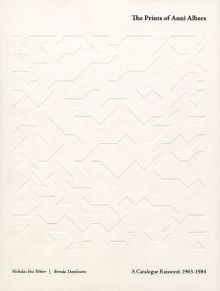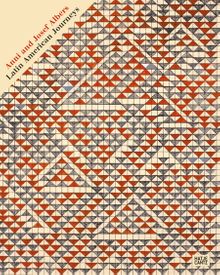| |||||||||||||||||||||||||
ARTIST MONOGRAPHS
|
|
STATUS: Out of stock Temporarily out of stock pending additional inventory. |
 The Prints of Anni Albers: Catalogue Raisonné
The Prints of Anni Albers: Catalogue Raisonné
Catalogue Raisonné
Published by RM/The Josef and Anni Albers Foundation.
Edited by Nicholas Fox Weber, Brenda Danilowitz.
PUBLISHER
RM/The Josef and Anni Albers Foundation
BOOK FORMAT
Clth, 9.25 x 12.25 in. / 200 pgs / 200 color / 30 bw.
PUBLISHING STATUS
Pub Date 10/31/2009
Out of print
DISTRIBUTION
D.A.P. Exclusive
Catalog: FALL 2009 p. 54
PRODUCT DETAILS
ISBN 9788492480524 TRADE
List Price: $70.00 CAD $85.00
AVAILABILITY
Not available
STATUS: Out of print | 00/00/00 For assistance locating a copy, please see our list of recommended out of print specialists |
 Bauhaus 1919-1933
Bauhaus 1919-1933
Workshops for Modernity
Published by The Museum of Modern Art, New York.
Text by Barry Bergdoll, Leah Dickerman, Benjamin H.D. Buchloh, Brigid Doherty, Hal Foster, Charles W. Haxthausen, Andreas Huyssen, Michael Jennings, Juliet Kinchin, Ellen Lupton, Christine Mehring, Detlef Mertins, Marco De Michelis, Peter Nisbet, Paul Monty Paret, Alex Potts, Frederic J. Schwarz, T'ai Smith, Adrian Sudhalter, Klaus Weber, Christopher Wilk, Matthew S. Witkovsky.
PUBLISHER
The Museum of Modern Art, New York
BOOK FORMAT
Clth, 9.5 x 12 in. / 328 pgs / 510 color.
PUBLISHING STATUS
Pub Date 12/11/2009
Out of print
DISTRIBUTION
D.A.P. Exclusive
Catalog: FALL 2009 p. 170
PRODUCT DETAILS
ISBN 9780870707582 TRADE
List Price: $85.00 CAD $105.00
AVAILABILITY
Not available
STATUS: Out of print | 00/00/00 For assistance locating a copy, please see our list of recommended out of print specialists |
 Anni & Josef Albers
Anni & Josef Albers
Latin American Journeys
Published by Hatje Cantz.
Edited by Brenda Danilowitz, Heinz Liesbrock. Text by Brenda Danilowitz, Jenny Anger, Kiki Gilderhus, et al.
Featuring previously unseen letters, manuscripts and photographs by the artists, as well as lush color plates of their artworks, this catalogue is the first to document the influence of Central and South America on the Albers’ work. It also makes the case that their art, as we know it today, cannot be understood without acknowledging their pivotal encounters in Latin America, for Anni’s weavings, drawings and painted studies demonstrate her deep knowledge of pre-Colombian textiles, and Josef’s paintings and photographs testify to the development of his unique sense of color in Mexico, as well as the formation of his independent concepts of photography and Formalism. One particularly stunning chapter, Hommage to the Pyramid includes Josef Albers’ photographic collages of South American Meso-American pyramids. The abstract, graphic quality of these images refers directly and surprisingly to both artists’ paintings and textiles.
PUBLISHER
Hatje Cantz
BOOK FORMAT
Hardback, 8.75 x 11.25 in. / 228 pgs / 172 color / 69 bw.
PUBLISHING STATUS
Pub Date 2/1/2008
Out of print
DISTRIBUTION
D.A.P. Exclusive
Catalog: SPRING 2008 p. 136
PRODUCT DETAILS
ISBN 9783775720571 TRADE
List Price: $60.00 CAD $70.00
AVAILABILITY
Not available
STATUS: Out of print | 11/25/2008 For assistance locating a copy, please see our list of recommended out of print specialists |
 Anni Albers
Anni Albers
Published by Guggenheim Museum Publications.
Edited by Nicholas Fox Weber and Pandora Tabatabai Asbaghi. Essays by Kelly Feeney, Jean-Paul Leclercq and Virginia Gardner Troy.
PUBLISHER
Guggenheim Museum Publications
BOOK FORMAT
Hardcover, 9.25 x 12 in. / 181 pgs / 148 color / 83 bw.
PUBLISHING STATUS
Pub Date 7/2/2003
Out of print
DISTRIBUTION
D.A.P. Exclusive
Catalog: FALL 2003
PRODUCT DETAILS
ISBN 9780892072729 TRADE
List Price: $60.00 CAD $70.00
AVAILABILITY
Not available
STATUS: Out of print | 4/1/2008 For assistance locating a copy, please see our list of recommended out of print specialists |
 Abstraction: The Amerindian Paradigm
Abstraction: The Amerindian Paradigm
Published by Societe des Expositions du Palais des Beaux-Arts de Bruxelles.
Artwork by Anni Albers, Josef Albers, Libero Badii, Helmut Federle, Gonzalo Fonseca, Adolph Gottlieb, Francisco Matto, Louise Nevelson, Alejandro Puente, Eduardo Ramirez Villamizar, Lenore Tawney, Joaquin Torres-Garcia, Paul Klee, Barnett Newman, Tony SmText by Cecilia de Torres, Valentin Ferdinan, Mary Frame, Cesar Paternosto, Piet Coessens, Lucy Lippard.
In their accompanying essays, Cesar Paternosto focuses on the emergence of an abstraction rooted on the indigenous arts of the Americas; Lucy R. Lippard writes on her experiences while researching the rock art of New Mexico; Mary Frame discusses the cultural resonance of textile structural forms in the ancient Andes; Cecilia de Torres narrates the story of the pioneering trecks to pre-Columbian sites by Torres-Garcia's disciples; and Valentin Ferdinan discusses the formative aspects of modern culture in Latin America.
PUBLISHER
Societe des Expositions du Palais des Beaux-Arts de Bruxelles
BOOK FORMAT
Hardcover, 8 x 11 in. / 172 pgs / 140 color / 106 bw.
PUBLISHING STATUS
Pub Date 2/2/2002
No longer our product
DISTRIBUTION
D.A.P. Exclusive
Catalog: SPRING 2002
PRODUCT DETAILS
ISBN 9789074816274 TRADE
List Price: $35.00 CAD $40.00
AVAILABILITY
Not available
